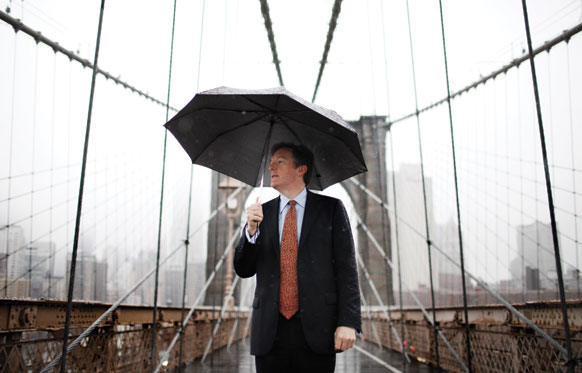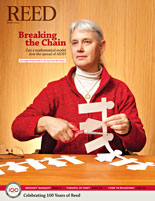
IRIS login | Reed College home Volume 91, No. 1: March 2012
The Maestro of Chaos

Photo by Michael Rubenstein
David Bragdon MALS ’10 is NYC’s master planner.
By Kurt Opprecht ’85
On a foggy winter morning, David Bragdon might be seen striding down the hill from his apartment in Fort Greene and walking up the ramp to the Brooklyn Bridge. As he passes beneath the first Gothic stone pylon and begins to summit the span, Manhattan opens below him like a diorama, a mad scrum of skyscrapers playing king of the hill in midtown; the Battery and seaport skirting the southern shoreline, the UN compound clinging to the edge of midtown, and the other bridges sewing the boroughs together to the north. From here, the metropolis can look almost serene, softened by the mist, as though it is merely sleeping in—until you descend into the roaring core of it, the heartless machinery, the overflowing structures, the jostling millions of humans working, living, breathing, and playing together. Not a bad way to get to the office when you’re the man in charge of charting the city’s future.
Amid all the hue and cry, David is like a tugboat pilot at the eye of a storm. His Portland cool deflects, by habit almost, the East Coast agita. Ask him about the forces vying for supremacy around the fulcrum of his office, and he offers calm explanations and cautious predictions. Having served eight years as president of Portland’s Metro Council, the regional government in charge of land-use planning, parks, and transportation, the man has polished steel rhetorical discretion. (It took some rhetorical skills of our own before he would acquiesce to an interview.)
Take a look at what he’s up against: it’s clear the only way to handle this job is with a grounded detachment. New York City will gain a million new residents over the next two decades. Every day, the city drinks a billion gallons of water, most of it delivered from a tunnel built in 1917; and pressure from hydrofracking for natural gas is threatening its watersheds a hundred miles away. Its sewer system is the stuff of legend (and we don’t mean the alligators). The network includes more than 135,000 catch basins, 6,000 miles of pipes, and 14 wastewater treatment plants. Even so, the city discharges some 30 billion gallons of unprocessed sewer overflows into its waterways each year.
At the heart of the Mayor’s Office for Long-Term Planning & Sustainability, which David directs, is PlaNYC, the master plan of what New York will look like in the year 2030. Ten chapters, 132 initiatives, a feast of charts with circles and arrows, it represents thousands of hours of pragmatic planning in transportation, climate impact, parks, storm water management, building codes, energy codes, and, yes, more bike lanes.
Asked to talk about one challenge in particular, David picks an area in which New York uncharacteristically lags: trash. Every single day, Gotham produces something in the smelly neighborhood of 11,000 tons of garbage—a monumental headache to haul, barge, and dump, especially for a city that lives mostly on islands.
But, what if we didn’t have to haul and bury the trash? Say we turn it into gas, yeah, burn that gas to generate electricity, and thus take a bite out of the city’s carbon footprint. The idea seems to work in Sweden and Denmark—could it work in NYC?
David is quick to point out the many challenges, among them how to pay for it, wrangling over potential sites, and clearing federal, state, and city regulations, but he remains cautiously optimistic. “Certainly any sort of new technology has to be evaluated and the impacts of it have to be weighed pretty carefully—how we assure that this is actually an environmentally and socially responsible approach to handling solid waste, what the emissions are, that sort of thing,” he says.
![]()
David came to the mayor’s office with broad experience navigating the seas of commerce, literally. He worked in Singapore, India, and the Soviet Union, under job titles that include marine marketing manager, assistant international traffic manager, and chartering assistant. He has always loved trains, a passion which sparked his interest in public transportation. Rounding out his transportation portfolio, he drove a cab in Portland for a while during his stint at the Metro Council.
He moved with his family from New York to Portland in 1971 so his father Paul Bragdon [president 1971–88] could take a position at a small liberal arts college there. Growing up so close to campus (a little more than a stone’s throw, as his father likes to say), David got plenty of exposure to Reed, and assumed that all colleges were similar. “And then, I went to a big eastern university where most of the professors didn’t care about the students at all. There were big lecture classes, an emphasis on regurgitating the texts, and a mindset that college is just about getting ready for law school.”
But it wasn’t until 20 years after graduating from Harvard that David finally got the chance to attend Reed through the Master of Arts in Liberal Studies program. “Even though I had a pretty demanding job, at the time, at the Metro Council, I felt that the MALS program used a different part of my brain,” he says. “It was like being part of a book club but on steroids, and where you also have to write papers.” One standout professor was Jay Dickson [English 1996–], from whom he took a class on the Bloomsbury group. “If I could take a class from Jay Dickson one night a week for the next 20 years, I’d do it.” He wrote his master’s paper on Herbert Croly (1869–1930), the progressive intellectual who founded the New Republic. “Understanding the Tea Party or Occupy Wall Street is a little easier if you know something about the Progressive Era, Theodore Roosevelt, and Herbert Croly,” he says. (And comes in handy, we suspect, when you work in city hall.)
In many ways, David has a progressive’s dream job, but his days working for the Bloomberg administration are numbered. Unless Mayor Mike wrangles another term out of the city council by 2014, David will be out on the street—which theoretically is his element. Until then, he’ll probably keep on walking to work on the Brooklyn Bridge, constructed for horse and foot traffic long before the automobile hijacked American roads. The bridge is usually described as a marvel of engineering, which is true enough, but it is also an elegant symbol of something else—the value of planning for a future we can only dimly see.


LATEST COMMENTS
steve-jobs-1976 I knew Steve Jobs when he was on the second floor of Quincy. (Fall...
Utnapishtim - 2 weeks ago
Prof. Mason Drukman [political science 1964–70] This is gold, pure gold. God bless, Prof. Drukman.
puredog - 1 month ago
virginia-davis-1965 Such a good friend & compatriot in the day of Satyricon...
czarchasm - 4 months ago
John Peara Baba 1990 John died of a broken heart from losing his mom and then his...
kodachrome - 7 months ago
Carol Sawyer 1962 Who wrote this obit? I'm writing something about Carol Sawyer...
MsLaurie Pepper - 8 months ago
William W. Wissman MAT 1969 ...and THREE sisters. Sabra, the oldest, Mary, the middle, and...
riclf - 10 months ago